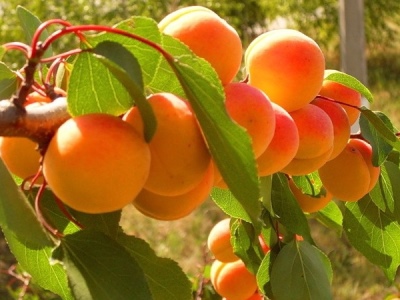
- Authors: V.A. Molchanov, A.N. Minin (Samara Botanical Garden and Samara Zonal Experimental Station for Gardening)
- Year of approval: 2005
- Tree height, m: until 6
- Escapes: thick, knobby, green, with a reddish tan on the sunny side
- Flowers: white-pink, large
- Fruit weight, g: 22
- Fruit shape: rounded
- Skin : thin
- Fruit color: orange, washed out with a blush on the sunny side
- Pulp color : Orange
At present, for the Volga residents, such a culture as apricot has long ceased to be exotic. Beautiful tall trees can be found today in many gardens on the Volga. The yield of a crop will largely depend on the variety, the geography of the site, agricultural technology and other factors. Therefore, first of all, it is worth paying attention to the apricot variety Kuibyshevsky Jubilee.
Breeding history
This wonderful culture was created back in 1964 by breeders Molchanov and Minin. The work was carried out in Samara, on the territory of the botanical garden and the zonal gardening station. The variety was obtained by the authors by sowing drupes of seedling No. 4 (the second name is Pamyat V. Ye. Otvinovskaya), freely pollinated in autumn in 1963.
Stages of development of the variety:
- 1987 - the culture "merged" into an elite group of plants;
- 2004 - the beginning of variety testing;
- 2005 - entry into the state register of the Russian Federation;
- 2007 - the variety received a patent.
Description of the variety
The 6-meter apricot tree is distinguished by strong and fast growth, has a rare wide-pyramidal crown. Branches are weakly branched. The color of the thick naked shoots is greenish, on the side facing the sun they are marked with a slight tan of reddish shades. Large matte leaf plates are usually broadly ovate, slightly concave, short-pointed, dark green in color, double-serrate at the edges. The tree is characterized by cracking and hard gray-brown bark.
It blooms in pinkish-white and rather large flowers. Apricot bears fruit on spurs, as well as on bouquet branches.
Fruit characteristics
Apricots of the traditional Volga variety are orange in color, and a dull blush appears on barrels growing in the sun. They are of medium size and weigh 22 grams. Rounded in shape, one-dimensional, in the region of the stalk, the fruit has a small inconspicuous depression. The abdominal suture is not particularly prominent. Apricots are easily separated from the short, thin stalk. The stone is medium in size, and it also moves freely from the pulp.
Taste qualities
The fruits of the described culture are tasty, sweet-sour, with a pleasant aroma. The pulp is colored in orange tones, it is slightly fibrous, juicy, the skin is thin. The juice is clear. Taste qualities of fresh fruits were assessed by experts-tasters on a 5-point scale at 4.4, compote - at 4.1, and appearance - at 4.5.
The product includes such useful components:
- 12.5% dry matter;
- 8.86% sugars;
- 1.88% acids;
- 10.31 mg / 100 g vitamin C;
- 2.08 mg / 100 g carotene;
- 1.18% pectin.
The transportability of apricots is good.
Ripening and fruiting
Kuibyshev Jubilee enters the fruiting phase in the 4th season, but it is annual. Refers to a group of crops with an average ripening period.

Yield
Six- and seven-year-old apricot trees of the crop under consideration bear 12-15 kg of fruits, while the plant reaches the maximum yield at the age of 12-13 years, and this is 40-50 kg. On average, the productivity of the crop is 60 kg / ha.
Growing regions
According to the tolerance, the culture is zoned for the Middle Volga region. This is a vast territory, including the republics of Mordovia, Tatarstan, as well as Penza, Samara, Ulyanovsk regions.
Self-fertility and the need for pollinators
It is a partially self-fertile culture. And the best pollinators for her are Kuibyshevsky early, Karlik, Samarsky.
Growing and care
Apricot trees of the considered variety will bear fruit better and more stable on any hill or hill, they develop very well near large rivers. In such places, there is less chance of damage to flowers and ovaries by recurrent spring frosts. According to the observations of the originators, in the Volga region, especially in the Sok River valley, the yield of the Kuibyshev Jubilee increases three times.
Formative pruning will be necessary for young plants, and during the period of stable fruiting, a maintenance annual one is repeated. Rejuvenating pruning will be necessary for apricots that have reached a certain age. During it, skeletal and semi-skeletal branches are removed.
Also, apricots are regularly watered and fed with fertilizers standard for fruit crops.



Disease and pest resistance
The disadvantage of this variety is the defeat of such a disease as moniliosis. It occurs under the condition of prolonged rains. The variety is resistant to other diseases, as well as to pests.

Winter hardiness and the need for shelter
Kuibyshev Jubilee is one of the winter-hardy varieties of apricots. Can withstand harsh winters and has been proven in practice. But the greatest damage to the plant can be caused by thaws, which alternate with frosts at the end of winter. Then the flower buds die.
Podoprevanie bark is unusual for the variety, it is resistant to this ailment. The same cannot be said for drought tolerance. In hot summers, fruits can shrink and crumble.































































